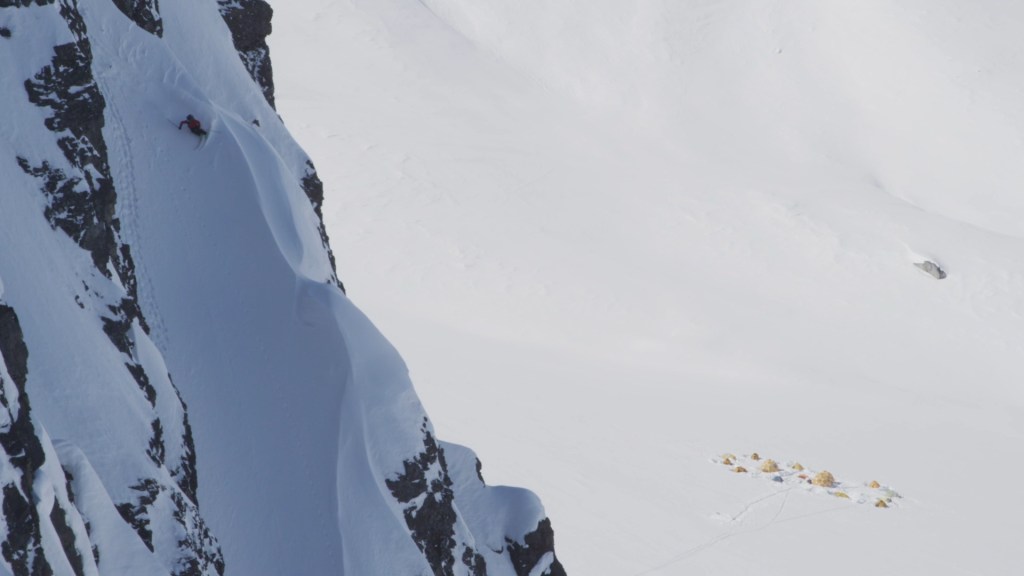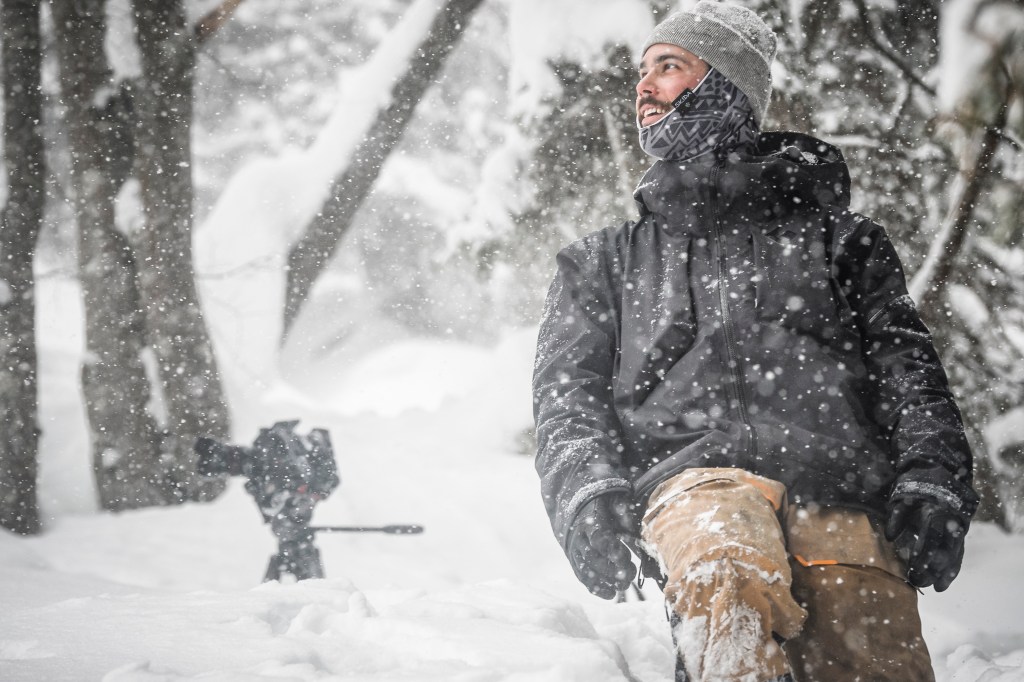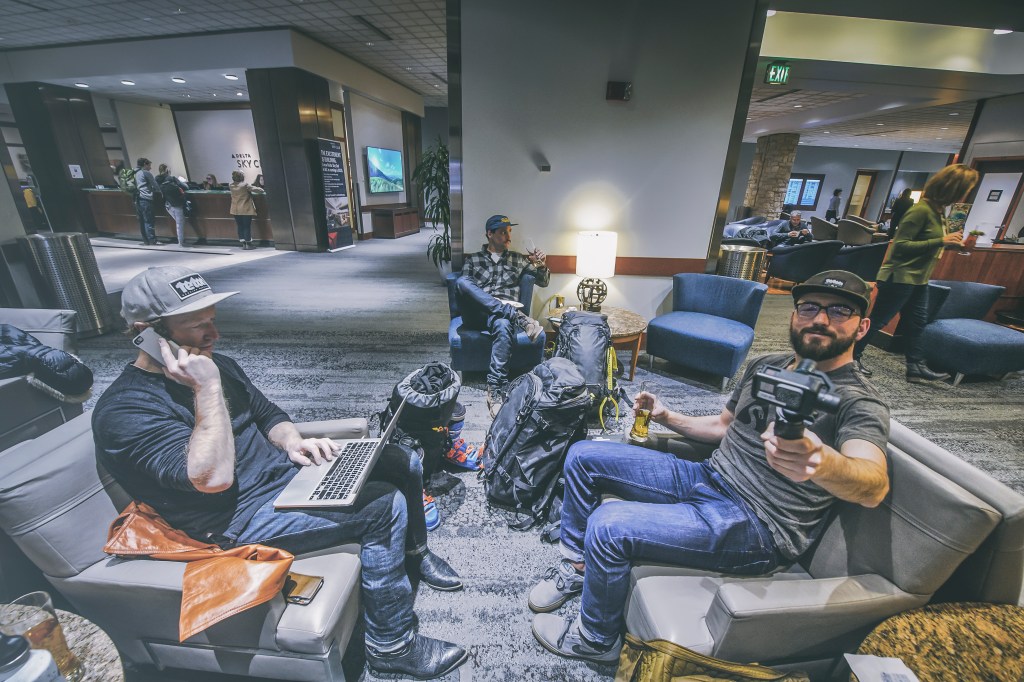The snow on the col is a mix of breakable crust, refrozen corn and ice. Pre-dawn light is providing just enough contrast to faintly make out our camp on a remote glacier in Alaska’s Hidden Mountains. I’m standing next to skiers Sage Cattabriga-Alosa and Ian McIntosh, and we all poke the snow with our poles on a variety of aspects, hoping that somehow, magically, the snow has transformed overnight. It hasn’t.

Griffin Post shreds a line above camp while filming in Alaska’s Tordrillo Mountains. (Photo Credit: TGR)
It’s late spring 2018, the last day of a two-and-a-half-week film trip for Teton Gravity Research’s latest movie, Far Out, presented by REI, which premieres this Saturday in Jackson Hole, Wyoming. The movie chronicles adventures in both backyard stashes and exotic, snow-covered destinations, all in a quest to find untapped dimensions.
On this trip, we’ve dealt with every snow condition except powder. We’ve woken up on the wrong side of 5am regularly, reluctantly crawling out of our sleeping bags to put on frozen ski boots. As we hiked out of camp on what was forecasted to be a blue-sky day, high clouds moved in from the west, foiling our last-ditch efforts to ski marginal snow.
But nobody is stressed. Instead, we’re laughing and joking about just how difficult the trip has been. Our seasoned athletes and film crew are used to this by now. Although the final version of high-production ski movies may seem like all helicopter skiing, perfect powder days and exotic, big-budget trips, many lesser moments end up on the cutting room floor.
If Far Out was an accurate portrayal of this winter, it would be 45 minutes of something going wrong and 15 minutes of action. That said, some of the best stories come out of the toughest trips. So, what exactly does it take to make 60 minutes of ski movie magic? Here’s a non-exhaustive list of factors we have to consider (and things that can go wrong).

What does it take to make a ski movie? A lot of standing around and waiting for the right conditions. (Photo Credit: TGR)
Safety
I sometimes joke that when I’m done with my skiing career, I’m going to play racquetball. I’d venture to guess that few games are canceled because the court isn’t safe. Snowpacks are complex, and at the end of the day, coming home safely is the top priority. Beyond assessing avalanche risk, athletes must also make the distinction between healthy fear—that riding down a mountain and jumping off cliffs is, in fact, scary—and a gut feeling that something isn’t right. For the record, any reason an athlete has to not ski something is a good enough reason for the rest of the crew. Safety concerns aren’t second-guessed.
Weather
Pro skiers are subject to the same weather as everyone else. In fact, it’s not uncommon for much of the movie’s footage to come from just a handful of high-quality days. This year in Albania, the crew sat for the better part of three weeks and eventually extended their trip to take advantage of a few sunny days where they got the majority of their footage. While some trips are planned months in advance, others are thrown together last minute based on where it’s snowing.
Last-minute plane tickets are expensive but not as expensive as wasting an entire trip skiing bad snow. Through a combination of forecasts, remote weather stations and ever-deceptive social media, plans are adjusted according to meteorological whims. However, as much as we try to stack the cards in our favor, sometimes the only way to find out is to go.

TGR cinematographer and drone pilot Austin Hopkins takes a break while shooting a deep powder day in Slovenia. (Photo Credit: TGR)
The Filming
The biggest unsung heroes of the film are the men and women behind the cameras. Ski cinematography involves the skilled use of complex, heavy and often fickle equipment in extreme environments. The chance of something going wrong is ever present: from batteries dying to misinterpreting a cue (the words “no” and “go” sound pretty similar over the radio, so now, we often use phrases like, “I’m 100 percent” to give the go-ahead). Without the hard-working crew, the skiing would still be amazing, but no one would ever know about it.

Cinematographer Nick Koldenhoven follows Robin Van Gyn in Slovenia. (Photo Credit: TGR)
The Actual Skiing
Lest we forget, when conditions and cinematography align, athletes still have to do their job. Odds are if the viewer is impressed by something, it wasn’t a gimme for the athlete. From forgetting to take one’s boots out of walk mode (seriously, that happens) to hitting a rock buried under the snow, skiing is not the easy part. Not to mention the months of weight and cardio training in the fall and honing in tricks in the early season, there’s far more to being a pro skier than being in the right place at the right time.

Sometimes just getting to the location is half the hurdle. Skier Griffin Post, cinematographer Austin Hopkins and producer Dutch Simpson during a layover. (Photo Credit: TGR)
The X Factor
Even when everything else goes right, there’s an endless list of unpredictable things that can go wrong. There was the time in Kashmir when an angry mob went after our production crew and we narrowly escaped into a taxi before things got violent. On a trip to Russia, my bags never showed up and for two weeks, I skied in borrowed gear except for my ski boots (always bring boots as carry-on). One summer in Chile, riots broke out near where we were staying and we couldn’t get to the mountains because every major road was blocked with burning trash.
Back on that ridge in Alaska, we don’t dwell on the fact that despite our preparation, today might not be our day. But, then, just as quickly as the clouds came in, they begin to part. As long as the weather holds, the snow is stable, the cinematographers can get to the right spots with charged batteries, nothing unforeseen happens and we nail our lines, it should be pretty easy from here on out.
